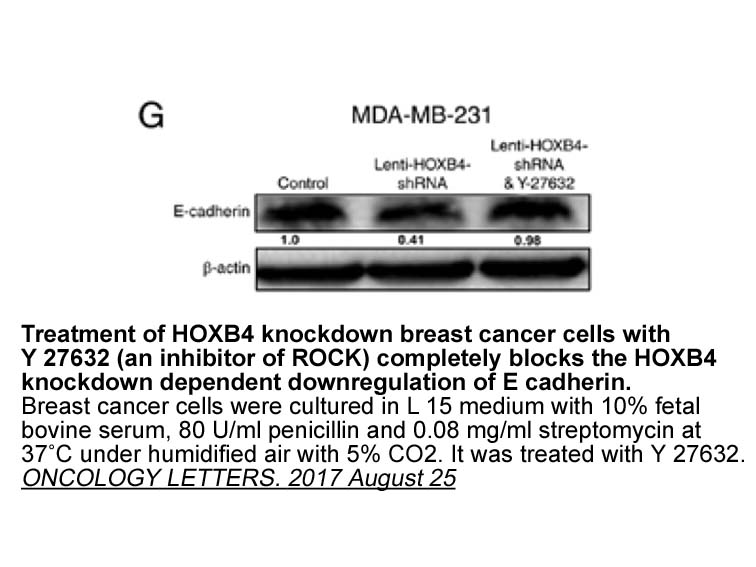Archives
The reception of antiangiogenic treatment
The reception of antiangiogenic treatment in neuro-oncology has yet to achieve the wide success rapidly accomplished for other malignancies. In 1984, mutated receptor tyrosine kinase became a culprit for aberrant tumorigenesis signal, providing a target for monoclonal CID 755673 sale (mAbs) and small-molecule TKIs. The mAbs and TKIs that target vascular endothelial growth factor (VEGF) or its receptors (VEGFR 1, 2, and 3) became of particular interest for their tumorigenic roles via neovascularisation and angiogenesis. A phase III trial using bevacizumab (Avastin) for metastatic colorectal cancer brought these agents to international medical attention, and now additional phase III trials have reproduced the success of such mABs for breast carcinoma, metastatic colorectal carcinoma, non–small cell lung cancer, and renal cell carcinoma. The reception of bevacizumab for glioblastomas, despite their highly angiogenic properties, has been less successful due to the lack of durable responses and survival benefits. Bevacizumab received accelerated U.S. Food and Drug Administration approval in 2009 for progressive glioblastoma after validation in 2 small, successful phase II studies, but not in 2 more recent phase III trials. Likewise, many multikinase VEGFR inhibitors are in phase II trials with only cediranib (a VEGFR TKI) having moved to a phase III trial for glioblastomas.
The case report by Arai et al also highlighted that we must revise how we radiographically approach primary brain tumors treated with antiangiogenic therapies in order to select for their success. Specialized imaging already exists to identify optimal antiangiogenesis treatment candidates for non-CNS tumors. Dynamic contrast computed tomography (CT) is a good predictor of outcomes in patients treated for advanced renal cell carcinoma on the basis of reductions in blood volume between baseline and follow-up. Intravoxel incoherent motion diffusion MRI correlates perfusion changes with outcomes in patients with non–small cell lung cancer. Perfusion measures on dynamic contrast-enhanced ultrasound have been associated with tumor shrinkage on CT in colorectal liver metastases. Developing examples in the setting of glioblastoma include a clinical trial for a positron emission tomography/CT tracer (F FPPRGD2) employed to specifically detect integrin-avb3, known to promote glioblastoma multiforme angiogenesis and possibly identify anti-VEGF susceptible patients. A new candidate MRI-contrast agent, ferumoxytol, quantifies the macrophage blockade response as a proxy for determining if cells are susceptible to VEGF.
However, with these new diagnostic technologies also comes the challenge of standardizing how we will objectively characterize tumor response following antiangiogenic therapy. Since antiangiogenic drugs have been used routinely, the criteria for radiographic response have expanded beyond contrast sequences to include the evaluation of noncontrast T2 or fluid-attenuated inversion recovery ones to verify the nonenhancing, infiltrative components. At Stanford University, we have been able to use perfusion imaging to demonstrate that those with elevated MRI perfusion pressures were more likely to respond to bevacizumab. A further complicating matter is that these agents have reported effects on normal tissue as well. Thus the thresholds for optimal sensitivity and specificity may need to be tailored to individual patients or therapeutics. Perhaps, as in the case report, ultimately when these patients present with possible new or recurrent brain tumors, histologic samples from surgical biopsy/debulking may provide the only answer.
Anti-VEGF treatment has also been used with limited s uccess in other brain lesions, and these radiographic adjuncts may be important for their future inclusion in the standard of care. There are retrospective case series looking at the role of bevacizumab in meningioma (grades II and III) and concluding that this therapy provides radiologically stable disease and some improvement of progression-free survival. Bevacizumab has also been used with some success in the treatment of vestibular schwannomas in neurofibromatosis type 2 patients (adults and children), with reported improvements in hearing and radiologically proven stable disease. Therefore the typical radiologic appearances of meningioma and vestibular schwannoma might also be affected in patients taking chronic antiangiogenic therapy for other systemic malignancy, complicating their diagnosis and medical management.
uccess in other brain lesions, and these radiographic adjuncts may be important for their future inclusion in the standard of care. There are retrospective case series looking at the role of bevacizumab in meningioma (grades II and III) and concluding that this therapy provides radiologically stable disease and some improvement of progression-free survival. Bevacizumab has also been used with some success in the treatment of vestibular schwannomas in neurofibromatosis type 2 patients (adults and children), with reported improvements in hearing and radiologically proven stable disease. Therefore the typical radiologic appearances of meningioma and vestibular schwannoma might also be affected in patients taking chronic antiangiogenic therapy for other systemic malignancy, complicating their diagnosis and medical management.